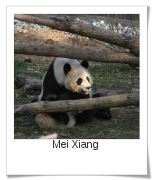The Smithsonian National Zoo has sent out a report on the cause of the death of
Mei Xiang
 Mei Xiang
美香 473
1998-Jul-22
Female
Smithsonian's National Zoo
WOLONG
Xue Xue - #444
LIn Nan - #298
's Cub, who died at only 6 days old. The full Email is included below.
Mei Xiang
美香 473
1998-Jul-22
Female
Smithsonian's National Zoo
WOLONG
Xue Xue - #444
LIn Nan - #298
's Cub, who died at only 6 days old. The full Email is included below.
Our pathologists have finished the final necropsy on Mei’s cub, and the panda team shared the results this morning. The initial necropsy, which was performed on September 23, showed that the week-old female cub had fluid in her abdomen and her liver was hard in places. There were no signs of internal or external trauma. The final necropsy determined that lung and liver damage ultimately caused the cub’s death. Her lungs were poorly developed and likely caused her to have insufficient oxygen, which would be consistent with the changes in the liver. The mortality rate for pandas in their first year in captivity is estimated to be 26 percent for males and 20 percent for females. Some early mortality rates may be underestimated.
We are working with our colleagues in China to answer questions about giant pandas that will ensure the best care in captivity and that will help bolster the species’ numbers in the wild. The information about how this cub died will add to the scientific body of knowledge about giant pandas. The Zoo will continue to work closely with its Chinese colleagues and share the information it has learned about giant panda reproduction and cub health.
Many of you have been asking about what our plans are for Mei and Tian. No decision has been made about their future. Our current agreement with China lasts through December 5, 2015 and stipulates that the Zoo will conduct research in the areas of breeding and cub behavior. Panda fans can still watch Mei and Tian on the panda cams, which are going to slowly convert to high-definition digital cameras thanks to a donation from the Ford Motor Company Fund, every day.
We are happy to report that Mei is almost completely back to her old self! Her hormones have returned to normal levels, as has her behavior. Mei is choosing to go outside in the mornings. In the afternoons she can usually be found napping on her indoor rockwork. Mei’s appetite has also returned, and she is eating almost all of her bamboo and all of her leaf eater biscuits and produce. The David M. Rubenstein Family Giant Panda Habitat is open, and visitors can see Tian Tian and
Mei Xiang
 Mei Xiang
美香 473
1998-Jul-22
Female
Smithsonian's National Zoo
WOLONG
Xue Xue - #444
LIn Nan - #298
outdoors and indoors, though the area directly around Mei’s den is still closed. The panda team expects that the entire David M. Rubenstein Family Giant Panda Habitat will be open soon, as Mei has not shown any sensitivity to noise lately.
Mei Xiang
美香 473
1998-Jul-22
Female
Smithsonian's National Zoo
WOLONG
Xue Xue - #444
LIn Nan - #298
outdoors and indoors, though the area directly around Mei’s den is still closed. The panda team expects that the entire David M. Rubenstein Family Giant Panda Habitat will be open soon, as Mei has not shown any sensitivity to noise lately.
Keepers cleaned the bamboo out of Mei’s den on Wednesday since she no longer spends much time there. Months ago, we installed a time-lapse camera in Mei’s den before she started building her nest in hopes that for the first time, we would have a visual record of how she built her nest. We retrieved it from the den this week. Unfortunately, we had some technical difficulties so it did not work out exactly as planned.Even though the progression is not as detailed as we would have liked, the photos still show some of Mei’s nesting. You can watch the time-lapse video made from the photos on our YouTube page.
